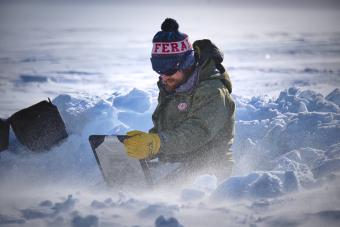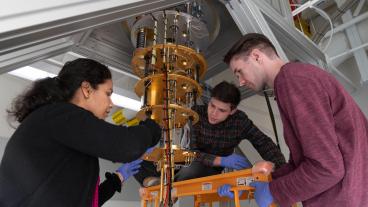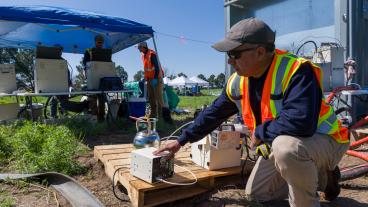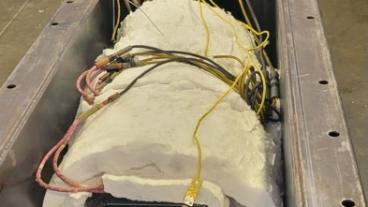Matthew Siegfried wins NSF CAREER Award for Antarctic ice stream research

Matthew Siegfried, assistant professor of geophysics, has participated in eight field seasons on Whillans Ice Stream, including a 61-day stint that overlapped the start of his job at Colorado School of Mines. (Photo courtesy of Phillipp Arndt/Scripps Institution of Oceanography)
Matthew Siegfried, assistant professor of geophysics at Colorado School of Mines, has received a National Science Foundation CAREER Award for work to improve our understanding of Antarctic ice streams – and their potential impact on global sea level change.
Ice streams are miles-wide rivers of ice within the larger Antarctic ice sheets that flow at speeds of tens of feet per day and account for most of the ice flow from an ice sheet into the ocean.
For his CAREER project, which will receive $696,481 in funding over five years, Siegfried will focus on Whillans Ice Stream in West Antarctica, whose flow has been slowing over the course of several decades. The goal of his research is to leverage decades of existing Global Positioning System (GPS) and seismic field data to illuminate what causes the slowing and ultimate shutdown of ice streams like Whillans.
“Any process that speeds up or slows down the rate at which these ice streams move adjusts the balance between ice gain and loss in Antarctica, impacting coastal communities worldwide,” Siegfried said. “We often focus on processes that make ice move faster—ice-stream stagnation, which most recently occurred in Antarctica about 180 years ago, is studied less often, particularly from an observational perspective.”
Here, Siegfried answers a few more questions about his latest research and the challenges of doing any kind of science in Antarctica’s harsh conditions.
Q: What is your latest research focused on?
Siegfried: My latest research draws from a long history of field projects to think about how ice streams change without any external forcing, such as a warming atmosphere or ocean. Ice streams are these huge, miles wide rivers of ice within an ice sheet that flow at speeds of tens of feet per day and account for most of the ice flow from an ice sheet to the ocean. In West Antarctica, there is a set of ice streams along a region called the Siple Coast that for as far back as we can infer change – 1,000-plus years – have been flipping from flowing fast to barely flowing at all due to internal variability of ice flow.
You can think of this region like a braided river, where streams of water can be redirected into neighboring streams with relative ease. A host of glaciology researchers have been studying the Siple Coast ice streams for the past 30-40 years, identifying past periods when an ice stream would, in the span of a few years to decades, slow down from speeds of 3-5 feet per day to moving less than an inch per day. The last time this occurred was around the time when Martin Van Buren was president, but another ice stream, Whillans Ice Stream, has been slowing down for a few decades now, seemingly primed for a full shutdown.
You can imagine there are quite a lot of open questions surrounding the details of how ice stream shutdown progresses when the last it happened was nearly two centuries ago, a time when nearly no one on Earth outside indigenous Arctic communities had any indication that ice could flow, let alone flow quickly. We are working on piecing together a patchwork of about 20 years of geophysical datasets from Whillans Ice Stream to dig into the details of its current deceleration.
Q: What do you find most exciting about your research?
Siegfried: I love probably a dozen different aspects of this research into internal ice-stream dynamics, but the part that I end up talking about the most is this effort to breathe new life into old field-based datasets. I have participated in eight field seasons on Whillans Ice Stream, living in a tent on top of this monster ice feature for over a year of my life – not consecutively of course. My longest continuous duration was 61 days, which overlapped with the start of my job here at Mines.
The amount of effort that goes into even a single day of field data collection in Antarctica hundreds of miles from the nearest base is immense—not just the humans physically there that miss birthdays, weddings, deaths, and many other “real life” events, but also the pilots who fly us there, the ground crews who keep planes running in inhospitable conditions, the cargo handlers who load our planes, the fuel experts who fill our 55-gallon drums with snow machine fuel, the mechanics who tune up the snow machines before we run them every day for weeks on end, the 24-hour operations staff who we check in with once a day to let the world know we are safe (one of whom, ironically, I overlapped with at Mines years later!), and the hundreds of other people without whom Antarctic fieldwork could not exist. And then, because of the nature of our academic research, we come back to the office, find the one or two most exciting bits of our hard-won dataset, and move on to the next project.
When I was a second-year PhD student, one of my first field mentors turned to me and, using as his example one of the simplest field instruments we have – the same technology each of us carry in our pockets every day – said, “If you put a GPS receiver anywhere in Antarctica, you can write a paper about it.” This off-hand comment first stuck with me as great job security – I have put dozens if not over a hundred GPS receivers in Antarctica! – but now over a decade later, sticks with me almost as a challenge: Sure, you can write a paper, but that’s the floor. Where is the ceiling? These datasets have plenty more insight to give us, and I am excited to find out exactly how much more.
Q: What is the potential impact of this work?
Siegfried: Week in, week out, there are news stories about the global impact of melting Earth’s ice masses. These stories invariable come with scary headlines about a bleak future due to accelerating ice mass loss. Our research community has been focused intensely on investigating potential “positive feedbacks” that could accelerate Antarctic contributions to sea-level change because, well, policymakers need a complete understanding of how bad our future may be. We need to continue identifying likely worst-case scenarios.
At the same time, there are processes that could slow down ice-mass loss, albeit sometimes only temporarily, and these need focused study as well, to understand if there is any potential for “buying time” when it comes to managing and mitigating climate risk and its inequities. Ice-stream shutdown is one of these processes that may temporarily ease rates of sea level rise along coastal margins: a Whillans Ice Stream shutdown reduces the Antarctic contribution to sea level change by a significant margin, about 25 percent. Ultimately, shutting down one ice stream leads to more flow through a neighboring ice stream, just like in a braided river, but past work seems to suggest that it takes longer to reorganize ice flow than it takes to shut down an ice stream. In other words, there may be a period of regional mass gain to offset mass losses elsewhere on the continent.
Q: How does this research agenda inform your teaching?
Siegfried: The research associated with this new project is centered on making the most of existing field-collected datasets. I have been incredibly fortunate to be able to participate in a substantial amount of field research in my career so far. The experience of being in the system you are studying opens new dimensions to how you think about the system itself, but these experiences are a privilege that most people will not have the opportunity or ability to participate in. We therefore need to bring the field to the classroom to make the experience of developing new research questions while existing in a system and of being inspired by the sheer magnitude of Earth processes accessible to all students.
As the director for our annual Geophysics Field Camp, I aim to bring these ideas to students at a local field site in Colorado, but for students interested in polar science, we need to leverage virtual technologies. Using immersive videos (which also should be considered a type of scientific data) collected in past field seasons, we are going to develop a suite of virtual “field trip” assignments with a variety of learning goals aimed at scientific question and hypothesis generation based on firsthand observations.




